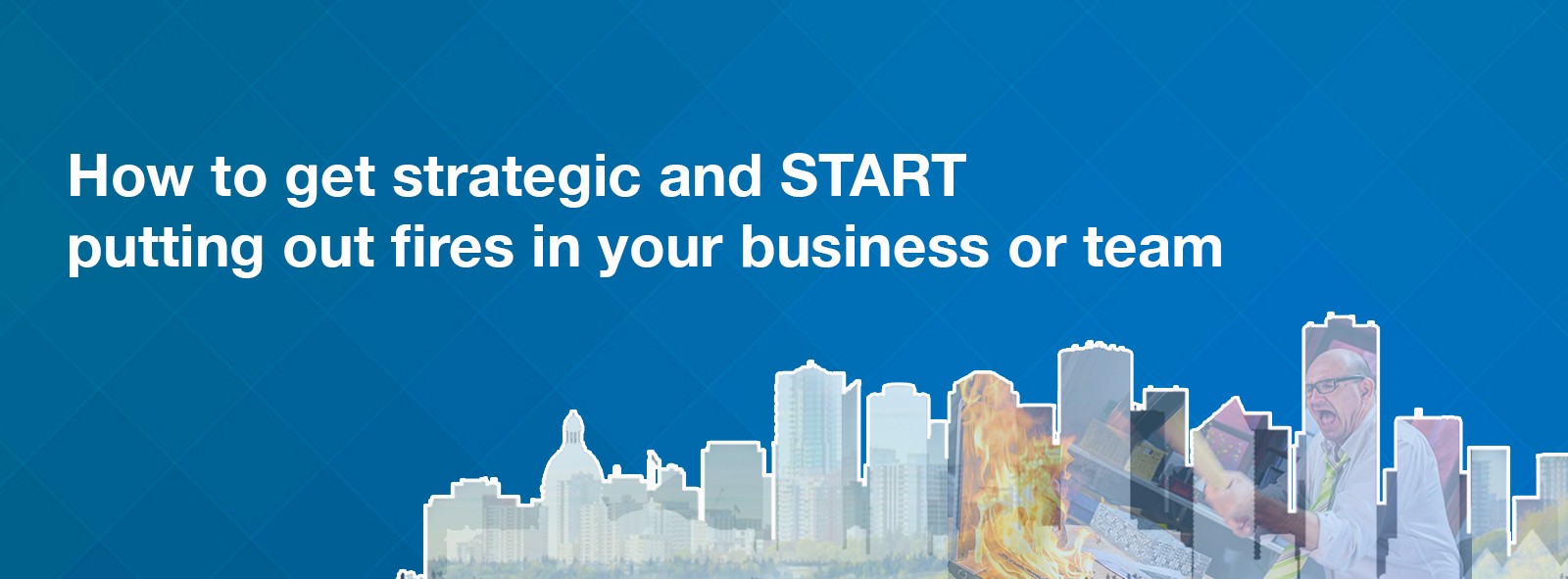Do you spend most of your time at work dealing with emergencies?…
Does your business day revolve around putting out fire after fire, and are you constantly working to respond to client needs (or demands) because you are worried that you will lose your customer to a competitor?
Many companies tell me they can’t plan or schedule because they are constantly bombarded with interruptions that have to be dealt with. I completely understand this dilemma because it’s a dilemma I share: as a business owner I too have to take the opportunities that arise, meet deadlines, deal with clients who need more that what I expected, technology that doesn’t work and employees who get sick.
On the other hand, in order for any business to be profitable, there need to be structures, standard operating procedures, clear communication lines and basic workflows. It’s not that businesses that find themselves always putting out fires don’t have any systems, it’s that they haven’t put the necessary reflection and thought into making sure their people:
- Have the most effective and efficient set of systems and technologies to do their work
- Know how to use the systems that affect them, and are motivated to follow through on all the necessary processes

Here’s the kicker: When you are a fire fighter, there isn’t less structure, there is more. Because you have to get to fires quickly wherever and whenever they happen, there are many structures, all organized and ready to be used in an instant.
Firefighters have to be so good at mastering systems and procedures, they could do them in their sleep. That’s the difference between really putting out fires and believing you have to respond to everything as if it were a fire.
Running your business, or your team, as if you were the person screaming, “Fire, do something!” is not a sustainable way to get those fires extinguished. Share on X
So what is stopping most business decision makers and managers from thinking and acting like actual firefighters?
Why are they instead reacting like panicked citizens watching the flames spread over their homes?
Well the key to getting from the “panicked citizen” to the true “fire fighter” is thinking in advance about what is likely to happen, then walking through the exact scenario with all the people and steps involved until you are certain you understand the process. This type of thinking goes by many names; here are a few:
- Value mapping
- Business process mapping
- Mind mapping
It can involve tools like a SWOT analysis, a fishbone analysis, a desired future state analysis and others, but it all starts by thinking about everything as a process and then walking through that process as a group exercise until you are sure you haven’t missed anything.
Let’s take the example of getting up in the morning and getting ready for work to illustrate. You get up to an alarm then head to the bathroom, use the toilet and the shower, find clothes to wear, go to the kitchen and make coffee and toast. In order to do those things, each action is dependent upon another set of actions that were planned in advance.
- Your phone needs to be charged and the alarm set, and you should put it near your bed so you can turn off your alarm quickly
- The bathroom needs towels, shampoo, soap, makeup or shaving gear, and water that comes on when you turn the tap
- You need to have purchased coffee, bread, jam and peanut butter to be able to make breakfast, and you will likely need a coffee machine or kettle, and a toaster, a plate, a knife, a cup and water, a table and a chair
If you can trace your process through each of these steps before you start then you have an efficient system that you can use no matter what happens. And it works exactly the same way with a smoothly running business or a smoothly running team.
Ready to get your team on track?

Let me illustrate further with an industry example that just happened in my office. We needed to have some of the windows replaced with fireproof glass and fireproof doors (speaking of firefighting), and this required quite a lot of things to be in place. The contractor came to the office to discuss what we needed, and offered various options and prices. Then the date and payment schedule were set, and the contractor gave us a timeline of 10 days to do the work.
We scheduled the office so that there were double the clients during the week preceding the construction, and no clients during construction week. The contractor set up various teams and told them when they needed to get their pieces done so the next trade could be scheduled in.
It worked like this:
- The scaffolding team set up scaffolds on Saturday and the designated supervisor used a scheduling app to indicate that work was done. A message was sent to the whole set-up team.
- Drop sheets and protective coverings were set down, furniture moved, and doors and windows removed and taken to a specified storage spot. Next, the team alerted that the job was on schedule.
- The door team came to hang steel doors while the window team brought in the new windows and installed them. When they finished, the designate alerted the trim team that they were ready.
- The trim team came and did door jamb and window framing. They alerted the painting team.
- The painting team finished their work and realized they had the wrong colours, so they alerted the clean-up team to wait one day. New paint was applied and the clean-up team called in.
- When the cleaning was done, the contractor came in to: inspect and talk to us about the job, make sure we saw everything, and check that we were satisfied.
Each team knew when to come in, had a back-up plan if there were delays, knew who to alert next and kept the contractor in the loop by using the same app to keep all teams on schedule. The groups were able to work so well together because they planned the job well, scheduled it realistically, communicated with each other often by phone.
They used the same app to indicate start and stop times for their pieces of the work, followed the necessary procedures, and had an agreed up on standard of cleanliness, excellence and client-facing attitudes. None of them seemed stressed out or angry, and they were not rude to each other. Each person supported the others and treated the incoming and outgoing teams with respect.
This didn’t just happen on its own, it was the result of carefully thought through workflows, communication tools and training that helped everyone to use the tools correctly.
There was a clear line of communication and everyone followed it. They were very careful to always close the loop on the work so each team knew exactly what was expected.
If we take this back to the firefighter scenario, all this advance planning enables firefighters to spring into action the moment there is a fire alarm. If they hadn’t trained, practiced, and drilled the procedures, they would never be ready to put them into action in a moment’s notice. The organized construction team of contractors that did our office windows were able to fit emergency jobs into their existing client schedule because they had these systems in place. The system made them more responsive to emergencies, not less responsive.
 Is this something you think you could set up in your organization?
Is this something you think you could set up in your organization?
It takes walking through the process step by step, mapping it out and then asking the people involved what you missed so all details are accounted for. Then, once that first workflow is in place, you will see where related workflows are missing and you’ll be able to develop them so your team understands how things are supposed to go and how they can respond appropriately.
It will take lots of open communication to get the procedures working with everyone. You will need to test each workflow to see where the problems are, and you can expect that there will always be problems – at least initially. But if you pay attention to the process, listen to the people closest to the job for key insights and information about how things are going, and if you communicate constantly, you will get to the point where things are in place.
That will be a good time to choose an appropriate technology for the process. Many businesses choose the technology before they know what processes they need it for, which is a great way to lose money and frustrate your employees. If you design your workflows correctly, the technology is always chosen to fit the process, not the other way around. Then you are in a position to ensure that everyone knows how to use the technology, and you begin another process design all over again!
The result of all this is that people are happy to do their jobs and have the tools they need to do them, open and effective communication becomes the norm, and clients show that they are very happy with your work.
What is key to remember is that process mapping ALWAYS need changes and improvements, so scheduled times to revisit workflows need to be put into the calendar to ensure everyone is still working in the same way and that it is all working. It may seem like a lot of planning and work and, I won’t sugar coat it, initially it can seem complex and hard to think through.
But once you get those first few systems running smoothly and everyone is using them with ease, you will be amazed how much more work you get done and with a lot less stress. Share on X
There will be less mistakes and re-work, and the issues you do have will be faster to fix. The other benefit your experience with process mapping will provide is that new workflow systems will become much faster to build because the learning you already did will form a baseline for new processes.
Learning to set up workflows in your business brings peace of mind because it shows all the employees involved why their role is so important and what they all stand to lose if any of the pieces are not done or if someone won’t communicate. So if you feel like you are always “putting out fires” at work, it is likely that you don’t have the right workflow systems in place to be actually able to deal with the fires you do have.
To lead in your business, you need to be a real firefighter, not a panicked citizen watching from the side as the building burns down. Share on X
Your action item from this is to start thinking about what workflow you could map out to get a handle on prepping your “fire hall” with the necessary processes to meet your next emergency.
Let me know how it goes!
People who read this article also read…
Is it true that some people can’t be motivated?
Lipstick and Beer. Business in tough times
Three Things Your Supervisors Are Doing Wrong And How To Fix Them
About Marie:
Marie Gervais, PhD., CEO of Shift Management Inc., provides managerial training and workforce interpersonal development to business and industry through online courses and web coaching. She helps individuals and organizations build talent and skills for leadership, communication, and conflict resolution particularly at the supervisory and middle management level. Her work has gained a reputation for excellence in integration and inclusion of the diverse workforce. With her team at Shift Management, Dr Gervais helps clients reach their business goals through team building coaching and industry-specific training development for interpersonal leadership skills. Her impactful digital and multi-media resources have been successfully implemented with many different populations and contexts. The results prove that a learning workplace is a happy and profitable one!
Check out Marie’s podcast Culture and Leadership Connections on Apple Podcasts and on the Shift website to hear stories of leadership and all things cultural. Consider the signature Supervisory Leadership Certificate Course for upskilling your workforce at:
https://shiftworkplace.com/courses/supervisory-leadership/
Contact information:
780 993 1062









